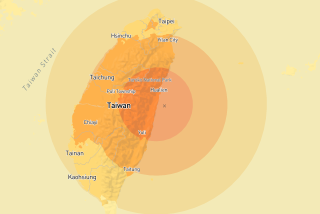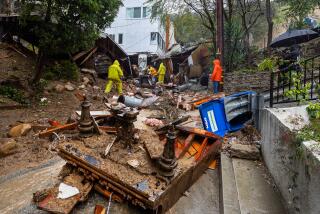California overhauling its tsunami evacuation scenarios
Emergency officials will soon be able to make improved tsunami evacuation orders as California writes detailed scenario plans, state authorities said Friday.
State officials realized a flaw in existing tsunami evacuation plans during the 2011 Japanese tsunami: Local officials couldn’t order a limited evacuation of specific neighborhoods closest to the shore. They had to take an all-or-nothing approach, ordering either no evacuation or evacuating an entire area that could be inundated under a worst-case tsunami.
“The approaching tsunami from Japan was big enough where it might inundate dry land, but not that much, especially because the tides were low. So there was really little consistency along the coast on the response. Some evacuated all their zone, and some didn’t evacuate it at all,” said Rick Wilson, senior engineering geologist with the California Geological Survey.
But officials have since begun to roll out refined strategies that will give authorities more flexibility in ordering limited evacuations in moderate tsunamis, the California Geological Survey said.
The first coastal counties to get the plans later this summer will be Orange, San Diego, Ventura, Monterey and Humboldt counties. Next up is Los Angeles, San Francisco, Alameda, San Luis Obispo and Del Norte counties for next year, with the rest to be completed by 2017, depending on funding.
“What we’re basically doing is creating what we call tsunami response playbooks. And we’re basically using a sports analogy for this: that the tsunami response playbook provides the best coastal defense for a tsunami of a particular size and source location,” Wilson said.
“We pick the correct defensive play to combat the tsunami, which is on the offensive. We incorporate all the factors which contribute to potential coastal flooding, like not only the tsunami height, but also storm and tidal conditions, to determine which evacuation playbook is the best to use,” Wilson said.
Officials said it would help authorities to not be afraid to order smaller evacuations.
“In 2011 ... most of the communities were kind of working on the fly to try to determine what they were going to do,” Wilson said.
The 2011 Japanese tsunami caused hundreds of millions of dollars in damage in California and one death, a young man taking pictures of the surging waves at the mouth of the Klamath River.
Local officials welcomed the updated plans. “No longer do we have an all-or-nothing response plan,” said Mike Davis, senior emergency services coordinator for the San Diego County Office of Emergency Services.
“It allows each jurisdiction to draft a specific plan to the unique needs of their community, so what might be happening in North County of San Diego … is different than what’s happening in the South Bay area,” Davis said.
The playbooks will be useful when California has several hours’ warning of a tsunami triggered on the other side of the ocean. A tsunami coming from Alaska is considered the worst-case scenario for Southern California, producing a surge as high as 10 to 15 feet, but the region would have roughly five to six hours of warning, Wilson said.
Such a tsunami could submerge many blocks of Long Beach and cause flooding in the affluent communities of Newport Bay and Huntington Harbour, a U.S. Geological Survey simulation published in 2013 said.
But the new playbook won’t help in locally generated tsunamis, which can come ashore in minutes. Residents and tourists need to remember to leave the coast as soon as they feel a quake, because of the risk of an underwater landslide triggering tsunami.
In Los Angeles County, a locally generated tsunami could bring water as high as 11 feet high in Redondo Beach, 8 feet at the ports of Los Angeles and Long Beach, 7 feet in Manhattan Beach and 5 feet in Marina del Rey, Wilson said.
“If you feel an earthquake, just go to high ground,” Wilson said. “It’s possible some of the coastal homes that are very close to the water and below a 10-foot elevation could get flooded. And if people that are on the beach don’t evacuate the beaches, there could be casualties.”
Friday’s announcement came just before Tsunami Preparedness Week begins next week. Officials are encouraging the public to go to the California’s tsunami website to look up their tsunami zone.
Newport Beach firefighters will hold a workshop at City Hall at 6:30 p.m. Wednesday. Officials say more than 40,000 residents there live in a tsunami flood zone.
On March 28 at 10 a.m., Hermosa Beach will begin its Tsunami Walk 2015, where participants will practice walking from the tsunami inundation zone to a safe location.
Funding for the new tsunami playbook comes from the National Tsunami Hazard Mitigation Program, which is operated by the National Oceanic and Atmospheric Administration.
For more news on earthquake safety and tsunamis, follow me on Twitter: @ronlin
More to Read
Sign up for Essential California
The most important California stories and recommendations in your inbox every morning.
You may occasionally receive promotional content from the Los Angeles Times.











